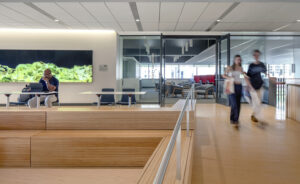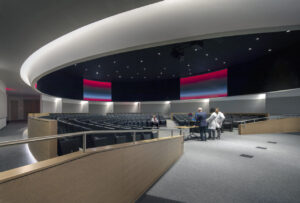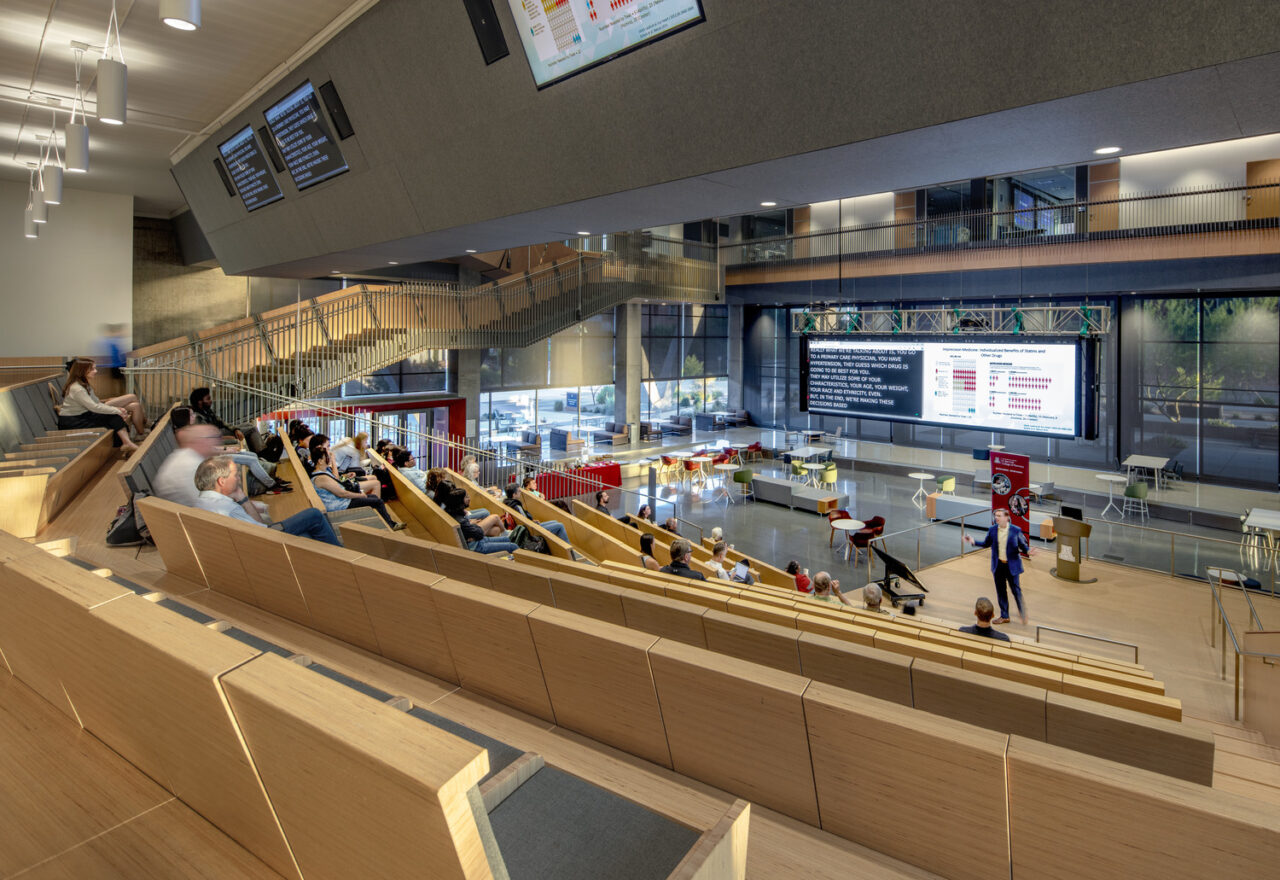The Forum at the University of Arizona’s Health Sciences Innovation Building is a ground-level space with an outdoor terrace and large load-in doors, doubling as a venue for community events. Photo Credit (all): Bill Timmerman, Courtesy CO Architects
By Megan Marsh
As education methods and types of spaces evolve, CO Architects is continually exploring emerging trends shaping the future of interiors in higher education. Our challenge as architects and interior designers is to create university environments that foster community, places that support collaboration, encourage interactions among people with varying points of view and forge human bonds. These key trends are important design elements shaping the future of higher education.
1. Flexibility

In an era where everyone must do more with less, flexible design solutions ensure that universities utilize spaces to their full potential. Flexible spaces and furniture that adapt to the future of education are a growing trend. Clients are also increasingly requesting agile spaces that are equipped to respond to various technologies and experiential needs. Many of our projects include movable partitions that allow classrooms to expand as well as large gathering areas that can be reconfigured to host various event types and group sizes, such as lectures, graduation ceremonies and TED Talks.
Designers are now combining business, education, and leisure in blended-use spaces instead of programming them separately for work or gathering. Co-mingling increases occupancy through varying uses throughout the day. Movable, versatile furniture is a vital aspect of space flexibility. Foldable and stackable furniture with integrated storage allows for quick reconfiguration for different activities.
2. Tech-Enabled Spaces

A corollary of flexible design is integrating current technology into campuses for both new buildings and modernizations of older ones to ensure longevity and relevancy. Examples include integrating Augmented Reality (AR) and Virtual Reality (VR) to enrich students’ campus and education experiences. The evolution of higher education design to focus on technology-driven learning environments as technology-enhanced spaces like AR and VR labs help make complex concepts easier to understand.
Other features routinely included are interactive smartboards, video-conferencing tools and other collaborative software as well as podcast rooms and recording studios for professors to professionally record lectures for hybrid learning, meeting current teaching needs but also accelerating new teaching methodologies.
3. Neurodiversity
Recognizing that students learn in a wide variety of ways, universities are becoming more accommodating to a range of cognitive and sensory preferences. Designs ensure that a choice of sensory environments is provided, in order to cater to diverse learning styles and needs. This can include a variety of study, learning and meeting environments, providing dimmable lighting and a range of color palettes. Collaboration areas vary from brighter rooms with plenty of natural light, to darker rooms with soft lighting as well as a range of visual and acoustical privacy elements. A mix of furniture types adds additional choices, allowing students to choose based on how they’re feeling at any given time.
4. Community-Fostering
The overall square footage in the education sector has remained relatively stable. However, space allocation has shifted toward slightly smaller private offices for faculty and an increase in flexible, shared workspaces or hybrid work models for faculty and staff.
This decrease in private workspaces is offset by a significant increase in public and community-life spaces, such as larger common areas, student lounges, collaboration zones and wellness facilities. Spaces that prioritize social interaction, support student well-being, and enhance campus life reflect a shift toward more communal, multi-functional environments within educational buildings.
5. Local Outreach
Higher education design increasingly considers and embraces the neighboring community. Multi-modal lecture spaces are often designed to also host community events, drawing residents onto campuses. Design details regularly embrace local influences and neighborhood history. Art installations often draw inspiration from the site surroundings and sometimes showcase the work of local artisans.
Visit the March/April edition of School Construction News to see how wellness, outdoor learning spaces and sustainability are also shaping the future of higher education.
Megan Marsh is a senior interior designer and senior associate in the Los Angeles office of CO Architects.


